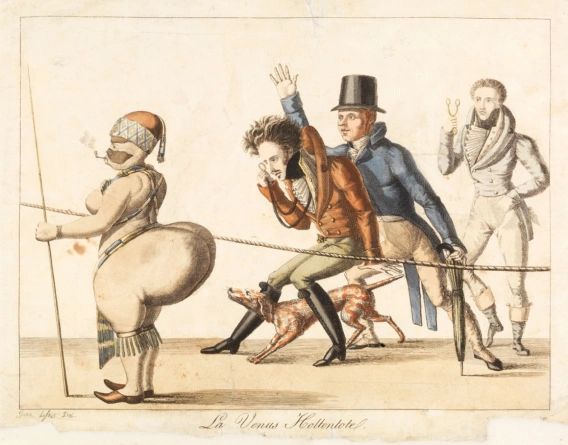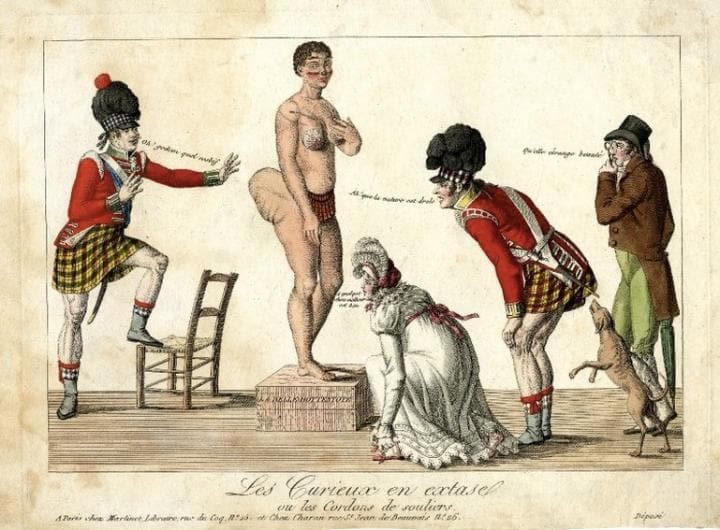The tragic story of Sarah Baartman, often referred to as the “Hottentot Venus,” is a deeply disturbing chapter in the history of colonial exploitation, racism, and objectification. Her life and the treatment she endured reveal the darkest aspects of human history, where individuals were dehumanised, exhibited as exotic curiosities, and subjected to relentless humiliation and suffering.
Sarah Baartman was born in the late 18th century, around 1789, in the Eastern Cape region of what is now South Africa. She belonged to the Khoikhoi people, an indigenous group with a distinct culture and language. Her early life was marked by the natural beauty that characterised her people, who were known for their fuller figures and unique cultural traditions.
In her youth, Sarah Baartman was a cattle herder and lived a traditional Khoikhoi lifestyle. Her life was peaceful and rooted in her ancestral traditions, as she had no inkling of the trials and tribulations that lay ahead.
Sarah Baartman’s life took a devastating turn when she came into contact with British colonialists and traders who arrived in South Africa. In 1810, her life was irrevocably changed when she was persuaded, coerced, or deceived into travelling to Europe under the guise of fame and fortune. The reasons behind her decision are shrouded in ambiguity, as she likely could not have fully comprehended the consequences of her actions or the deception of the individuals who persuaded her to go.
Upon her arrival in Europe, it became clear that she had been lured into a life of exploitation and objectification. She was placed on exhibit, paraded as an exotic curiosity, and subjected to the grotesque fascination of European audiences. Her fuller figure, particularly her enlarged buttocks and elongated labia, was sensationalised and presented as a source of fascination and amusement.
Sarah Baartman’s exhibition in Europe was not merely an instance of exploitation; it was also grounded in the deeply entrenched beliefs of scientific racism. In the 19th century, European “scientists” and pseudo-anthropologists sought to justify racial hierarchies and the exploitation of non-European peoples through distorted pseudoscience.
Baartman’s body was subjected to extensive examination and objectification by these so-called scientists. They used her as a means to propagate the notion of racial superiority, emphasising perceived differences between European and African physiognomies. Her treatment was an early, tragic example of how pseudo-scientific racism sought to legitimise the dehumanisation of non-European peoples.

Sarah Baartman’s life in Europe was one of dehumanisation, humiliation, and suffering. She was put on display in various exhibitions, often unclothed and subjected to the leering gazes of a voyeuristic public. Her exhibitions were characterised by demeaning commentary, and she was frequently forced to perform degrading acts for the amusement of the audience.
The horrors of her experience were compounded by the inhumane treatment she received from those who profited from her exploitation. Baartman’s tragic journey through Europe took her to various cities, including London and Paris, where she endured unimaginable hardships. Throughout her time on display, she was never afforded the dignity and respect that should be the birthright of every human being.
Despite the brutality she faced, Sarah Baartman’s spirit was not entirely broken. In the midst of her ordeal, she sought assistance from individuals who recognised the injustice of her situation. She made efforts to escape her captors and return to South Africa, albeit with limited success.
In 1814, a group of abolitionists in London became aware of her situation and initiated legal proceedings to free her from her captors. However, her release did not result in a return to a peaceful life in her homeland. She was placed under the guardianship of a showman named Henry Taylor, who continued to exploit her.
Sarah Baartman’s life took a final tragic turn when she passed away in 1815, at the young age of 25. The exact circumstances of her death remain a matter of debate. Some reports suggest that she died of an inflammatory ailment, likely related to alcoholism and the deplorable living conditions to which she had been subjected.
Her tragic demise, however, did not mark the end of her exploitation. Even in death, her body was not allowed to rest in peace. It was dissected, preserved, and placed on exhibit. Her brain and genitals were removed, and her remains were displayed in jars and on museum shelves as objects of scientific curiosity.
The legacy of Sarah Baartman is a haunting and powerful reminder of the depths to which human beings can descend when fueled by racism, colonialism, and greed. Her story has had a profound impact on the discourse surrounding human rights, racism, and exploitation.

Sarah Baartman’s story served as a catalyst for early human rights and anti-slavery movements. Abolitionists used her case to highlight the inhumanity of the slave trade and the exploitation of indigenous people. Her story prompted important questions about the morality and legality of such exploitative exhibitions.
In the 20th and 21st centuries, there were growing calls for the repatriation of Sarah Baartman’s remains. South African activists and government officials pushed for the return of her remains to her homeland, where they could finally receive a dignified burial. This effort culminated in 2002 when her remains were repatriated to South Africa.
Today, Sarah Baartman is remembered not as a victim but as a symbol of resilience, strength, and the enduring fight for justice. Her story has inspired artists, writers, and activists to explore themes of exploitation, racism, and colonialism. Her memory serves as a reminder of the importance of acknowledging and confronting the darkest chapters of human history.
The story of Sarah Baartman, the “Hottentot Venus,” is a tragic tale of colonial exploitation, scientific racism, and the dehumanisation of an innocent woman. Her life, marked by suffering and objectification, serves as a stark reminder of the depths to which humans can descend when motivated by greed and prejudice. While her story is painful to recount, it is essential to remember her and the countless others who suffered similar fates as a testament to the ongoing struggle for justice, equality, and human dignity. Sarah Baartman’s legacy endures as a symbol of resilience and a call to confront the darkest aspects of our shared history.
SOURCES
- https://en.wikipedia.org/wiki/Khoekhoe
- https://www.blackpast.org/global-african-history/baartman-sara-saartjie-1789-1815/#:~:text=Sara%20Baartman%20was%20born%20in,most%20likely%20worked%20as%20servants.
- https://www.pulse.ng/lifestyle/food-travel/the-tragic-story-of-sarah-baartman-a-overlysexualised-black-woman/8psqgct
- https://original.newsbreak.com/@watch7-1719602/3128463584432-revealing-the-injustice-of-history-the-heartbreaking-exploitation-of-sarah-baartman




